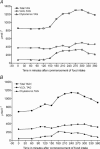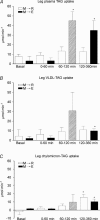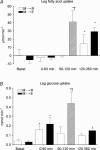Postprandial triacylglycerol uptake in the legs is increased during exercise and post-exercise recovery
- PMID: 16020461
- PMCID: PMC1464194
- DOI: 10.1113/jphysiol.2005.091975
Postprandial triacylglycerol uptake in the legs is increased during exercise and post-exercise recovery
Abstract
Six young, healthy male subjects were each studied in two experiments: (1) during resting conditions before and for 360 min after a meal (54% of energy as carbohydrate, 30% of energy as lipid, and 16% of energy as protein) comprising 25% of their total daily energy intake (M-->R); and (2) while exercising on a cycle ergometer for 60 min at 50% of the peak oxygen consumption commencing 60 min after the meal (M-->E) and then for another 240 min. Regional metabolism was measured by Fick's Principle in a leg and in the splanchnic tissue. The combination of food intake and exercise led to increased plasma triacylglycerol (TAG) uptake and clearance in the exercising legs immediately and for at least 4 h post-exercise, while food intake per se did not change leg plasma TAG uptake or clearance for up to 6 h. It is hypothesized that the effect of exercise on leg plasma TAG metabolism is a result of capillary recruitment leading to exposure of the plasma lipoprotein particles to a larger amount of active LPL. In spite of the increased TAG uptake in the exercising legs the arterial plasma TAG concentration had a tendency to increase faster during exercise after a meal than during rest, but it also decreased faster implying that the total lipaemic response was the same whether exercise was performed or not. The amount of lipid taken up in the legs was higher than could be accounted for by whole body lipid oxidation during post-exercise recovery, indicating accumulation of lipid in skeletal muscle in this period. Neither food intake alone nor the combination of food and exercise affected the splanchnic net balance of TAG. Finally, there is an additive effect of exercise and food intake on splanchnic net glucose balance.
Figures





Similar articles
-
Endurance training has little effect on active muscle free fatty acid, lipoprotein cholesterol, or triglyceride net balances.Am J Physiol Endocrinol Metab. 2006 Sep;291(3):E656-65. doi: 10.1152/ajpendo.00020.2006. Epub 2006 May 9. Am J Physiol Endocrinol Metab. 2006. PMID: 16684856 Clinical Trial.
-
The combined effects of exercise and food intake on adipose tissue and splanchnic metabolism.J Physiol. 2004 Dec 15;561(Pt 3):871-82. doi: 10.1113/jphysiol.2004.076588. Epub 2004 Oct 21. J Physiol. 2004. PMID: 15498802 Free PMC article.
-
A single bout of whole-body resistance exercise augments basal VLDL-triacylglycerol removal from plasma in healthy untrained men.Clin Sci (Lond). 2009 Jan;116(2):147-56. doi: 10.1042/CS20080078. Clin Sci (Lond). 2009. PMID: 18554182 Clinical Trial.
-
Are the arms and legs in competition for cardiac output?Med Sci Sports Exerc. 2006 Oct;38(10):1797-803. doi: 10.1249/01.mss.0000230343.64000.ac. Med Sci Sports Exerc. 2006. PMID: 17019302 Review.
-
High-Intensity Interval Exercise and Postprandial Triacylglycerol.Sports Med. 2015 Jul;45(7):957-68. doi: 10.1007/s40279-015-0327-6. Sports Med. 2015. PMID: 25851583 Review.
Cited by
-
The Physiological Regulation of Skeletal Muscle Fatty Acid Supply and Oxidation During Moderate-Intensity Exercise.Sports Med. 2015 Nov;45 Suppl 1(Suppl 1):S23-32. doi: 10.1007/s40279-015-0394-8. Sports Med. 2015. PMID: 26553490 Free PMC article. Review.
-
Glucagon-like peptide-1 elicits vasodilation in adipose tissue and skeletal muscle in healthy men.Physiol Rep. 2017 Feb;5(3):e13073. doi: 10.14814/phy2.13073. Physiol Rep. 2017. PMID: 28174344 Free PMC article.
-
Determinants of intramyocellular lipid accumulation after dietary fat loading in non-obese men.J Diabetes Investig. 2011 Aug 2;2(4):310-7. doi: 10.1111/j.2040-1124.2010.00091.x. J Diabetes Investig. 2011. PMID: 24843504 Free PMC article.
-
Silencing of glycolysis in muscle: experimental observation and numerical analysis.Exp Physiol. 2010 Feb;95(2):380-97. doi: 10.1113/expphysiol.2009.049841. Epub 2009 Oct 2. Exp Physiol. 2010. PMID: 19801387 Free PMC article.
-
The Effect of a Single Bout of Continuous Aerobic Exercise on Glucose, Insulin and Glucagon Concentrations Compared to Resting Conditions in Healthy Adults: A Systematic Review, Meta-Analysis and Meta-Regression.Sports Med. 2021 Sep;51(9):1949-1966. doi: 10.1007/s40279-021-01473-2. Epub 2021 Apr 27. Sports Med. 2021. PMID: 33905087 Free PMC article.
References
-
- Aldred HE, Perry IC, Hardman AE. The effect of a single bout of brisk walking on postprandial lipemia in normolipidemic young adults. Metabolism. 1994;43:836–841. - PubMed
-
- Bülow J. Adipose tissue blood flow during exercise. Dan Med Bull. 1983;30:85–100. - PubMed
-
- Bülow J, Madsen J. Influence of blood flow on fatty acid mobilization form lipolytically active adipose tissue. Pflugers Arch. 1981;390:169–174. - PubMed
-
- Bülow J, Simonsen L, Wiggins D, Humphreys SM, Frayn KN, Powell D, Gibbons GF. Co-ordination of hepatic and adipose tissue lipid metabolism after oral glucose. J Lipid Res. 1999;40:2034–2043. - PubMed
Publication types
MeSH terms
Substances
LinkOut - more resources
Full Text Sources
Other Literature Sources

